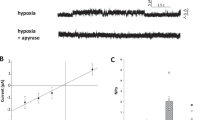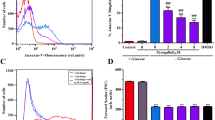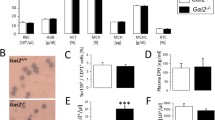Abstract
This study examined the role of a P2 receptor and arachidonic acid (AA) in regulatory volume decrease (RVD) by American alligator red blood cells (RBCs). Osmotic fragility was determined optically, mean cell volume was measured by electronic sizing, and changes in intracellular Ca2+ concentration were visualized using fluorescence microscopy. Gadolinium (50 μM), hexokinase (2.5 U/ml), and suramin (100 μM) increased osmotic fragility, blocked volume recovery after hypotonic shock, and prevented a rise in intracellular Ca2+ that normally occurs during cell swelling. The P2X antagonists PPADS (50 μM) and TNP-ATP (10 μM) also increased fragility and inhibited volume recovery. In contrast, ATPγS (10 μM), α,β-methylene-ATP (50 μM) and Bz-ATP (50 μM) had the opposite effect, whereas 2-methylthio-ATP (50 μM) and UTP (10 μM) had no effect. In addition, the phospholipase A2 (PLA2) inhibitors ONO-RS-082 (10 μM), chlorpromazine (10 μM), and isotetrandrine (10 μM) increased osmotic fragility and blocked volume recovery, whereas AA (10 μM) and its nonhydrolyzable analog eicosatetraynoic acid (ETYA, 10 μM) had the reverse effect. Further, AA (10 μM), but not ATPγS (10 μM), prevented the inhibitory effect of a low Ca2+-EGTA Ringer on RVD, whereas both AA (10 μM) and ATPγS (10 μM) caused cell shrinkage under isosmotic conditions. In conclusion, our results are consistent with the presence of a P2-like receptor whose activation stimulated RVD. In addition, AA also was important for volume recovery.









Similar content being viewed by others
References
Boudreault F, Grygorczyk R (2002) Cell swelling-induced ATP release and gadolinium-sensitive channels. Am J Physiol Cell Physiol 282:C219–C226
Braunstein GM, Roman RM, Clancy JP, Kudlow BA, Taylor AL, Shylonsky VG, Jovov B, Peter K, Jilling T, Ismailov II, Benos DJ, Schwiebert LM, Fitz JG, Schwiebert EM (2001) Cystic fibrosis transmembrane conductance regulator facilitates ATP release by stimulating a separate ATP release channel for autocrine control of cell volume regulation. J Biol Chem 276:6621–6630
Brown EM, Gamba G, Riccardi D, Lombardi M, Butters R, Kifor O, Sun A, Hediger MA, Lytton J, Hebert SC (1993) Cloning and characterization of an extracellular Ca2+-sensing receptor from bovine parathyroid. Nature 366(6455):575–580
Burnstock G (2009) Puringergic signaling: past, present and future. Bras J Med Biol Res 42:3–8
Crumling MA, Tong M, Aschenbach KL, Liu LQ, Pipitone CM, Keith R (2009) P2X antagonists inhibit styryl dye entry into hair cells. Neurosci 161:1144–1153
Danthi S, Enyeart JA, Enyeart JJ (2003) Modulation of native TREK-1 and Kvl.4 K+ channels by polyunsaturated fatty acids and lysophospholipids. J Membr Biol 195:147–164
Davies JP, Robson L (2010) Pharmacological properties and physiological function of a P2X-like current in single proximal tubule cells isolated from frog kidney. J Membr Biol 237:79–91
Dezaki K, Tsumura T, Maeno E, Okada Y (2000) Receptor-mediated facilitation of cell volume regulation by swelling-induced ATP release in human epithelial cells. Jpn J Physiol 50:235–241
Doody AM, Antosh AL, Brown WJ (2009) Cytoplasmic phospholipase A2 antagonists inhibit multiple endocytic membrane trafficking pathways. Biochem Biophys Res Commun 388:695–699
Ellsworth ML, Ellis CG, Goldman D, Stephenson AH, Dietrich HH, Sprague RS (2008) Erythrocytes: oxygen sensors and modulators of vascular tone. Physiology 24:107–116
Elperin AB, Pore SA, Evans JM, Naditz AL, Light DB (2011) Swelling-induced Ca2+ influx and K+ efflux in American alligator erythrocytes. J Membr Biol 240:1–12
Gever JR, Cockayne DA, Dillon MP, Burnstock G, Ford AP (2006) Pharmacology of P2X channels. Pflugers Arch 452:513–537
Gonzalez-Alonso J, Olsen DB, Saltin B (2002) Erythrocyte and the regulation of human skeletal muscle blood flow and oxygen delivery: role of circulating ATP. Circ Res 91:1046–1055
Hernandez T, Coulson RA (1952) Hibernation in the alligator. Proc Soc Exp Biol Med 79:145–149
Hoffmann EK, Lambert IH, Pedersen SF (2009) Physiology of cell volume regulation in vertebrates. Physiol Rev 89:193–277
Hua SZ, Gottlieb PA, Heo J, Sachs F (2010) A mechanosensitive ion channel regulating cell volume. Am J Physiol Cell Physiol 298:C1424–C1430
Jakab M, Furst J, Gschwentner M, Botta G, Garavaglia ML, Bazzini C, Rodughiero S, Meyer G, Eichmueller S, Woll E, Chwatal S, Ritter M, Paulmichl M (2002) Mechanisms sensing and modulating signals arising from cell swelling. Cell Physiol Biochem 12:235–258
Jarvis MF, Burgard EC, McGaraughty S, Honore P, Lynch K, Brennan TJ, Subieta A, van Biesen T, Cartmell J, Bianchi B, Niforatos W, Kage K, Yu H, Mikusa J, Wismer CT, Zhu CZ, Chu K, Lee CH, Stewart AO, Polakowski J, Cox BF, Kowaluk E, Williams M, Sullivan J, Faltynek C (2002) A-317491, a novel potent and selective non-nucleotide antagonist of P2X3 and P2X2/3 receptors, reduces chronic inflammatory and neuropathic pain in the rat. Proc Natl Acad Sci USA 99:17179–17184
Jenkins CM, Cedars A, Gross RW (2009) Eicosanoid signaling pathways in the heart. Cardiovasc Res 82:240–249
Koivusalo M, Kapus A, Grinstein S (2009) Sensors, transducers, and effectors that regulate cell size and shape. J Biol Chem 284:6595–6599
Lambrecht G (2000) Agonists and antagonists acting at P2X receptors: selectivity profiles and functional implications. Naunyn Schmiedebergs Arch Pharmacol 362:340–350
Lance VA, Elsey RM (1999) Hormonal and metabolic responses of juvenile alligators to cold shock. J Exp Zoo 283:566–572
Lang F (2007) Mechanisms and significance of cell volume regulation. J Am Coll Nutr 26:613S–623S
Lang F, Busch GL, Volkl H (1998) The diversity of volume regulatory mechanisms. Cell Physiol Biochem 8:1–45
Lee YS (2009) Arachidonic acid activates K-Cl-cotransport in HepG2 human hepatoblastoma cells. Korean J Physiol Pharmacol 13:401–408
Locovei S, Bao L, Dahl G (2006) Pannexin 1 in erythrocytes: function without a gap. Proc Natl Acad Sci USA 103:7655–7659
Mastrocola T, Flamigni A, Rugolo M (1991) Hypotonic shock activated Cl− and K+ pathways in human fibroblasts. Biochim Biophys Acta 1069:201–208
Mignen O, Le Gall C, Harvey BJ, Thomas S (1999) Volume regulation following hypotonic shock in isolated crypts of mouse distal colon. J Physiol 515:501–510
Nakamura T, Iwanaga K, Murata T, Hori M, Ozaki H (2011) ATP induces contraction mediated by the P2Y2 receptor in rat intestinal subepithelial myofibroblasts. Eur J Pharmacol 657:152–158
Neelands TR, Burgard EC, Uchic ME, McDonald HA, Niforatos W, Faltynek CR, Lynch KJ, Jarvis MF (2003) 2′,3′-O-(2,4,6, trinitrophenyl)-ATP and A-317491 are competitive antagonists at a slowly desensitizing chimeric human P2X3 receptor. Br J Pharmacol 140:202–210
Okada Y, Maeno E, Shimizu T, Dezaki K, Wang J, Morishima S (2001) Receptor-mediated control of regulatory volume decrease (RVD) and apoptotic volume decrease (AVD). J Physiol 532:3–16
Olearczyk JJ, Stephenson AH, Lonigro AJ, Sprague RS (2004) NO inhibits signal transduction pathway for ATP release from erythrocytes via its action on heterotrimeric G protein Gi. Am J Physiol Heart Circ Physiol 287:H748–H754
Ollivier H, Pichavant K, Puill-Stephan E, Calves P, Nonnotee L, Nonnotte G (2006a) Effects of hypo-osmotic stress on ATP release in isolated turbot (Scophthalmus maximus) hepatocytes. Biol Cell 98:427–437
Ollivier H, Pichavant-Rafini K, Puill-Stephan E, Roy S, Calves P, Nonnotee L, Nonnotte G (2006b) Volume regulation following hyposmotic shock in isolated turbot (Scophthalmus maximus) hepatocytes. J Comp Physiol B 176:393–403
Pafundo DE, Mut P, Perez Recalde M, Gonzalez-Lebrero RM, Fachino V, Krumschnabel G, Schwarzbaum PJ (2004) Effects of extracellular nucleotides and their hydrolysis products on regulatory volume decrease of trout hepatocytes. Am J Physiol Regul Integr Comp Physiol 287:R833–R843
Pasantes-Morales H, Morales SM (2000) Influence of calcium on regulatory volume decrease: role of potassium channels. Nephron 86:414–427
Shinozuka K, Tanaka N, Kawasaki K, Mizuno H, Kubota Y, Nakamura K, Hashimoto M, Kunitomo M (2001) Participation of ATP in cell volume regulation in the endothelium after hyptonic stress. Clin Exp Pharmacol Physiol 28:799–803
Skals M, Jorgensen NR, Leipziger J, Praetorius HA (2009) Alpha-hemolysin from Escherichia coli uses endogenous amplification through P2X receptor activation to induce hemolysis. Proc Natl Acad Sci USA 106:4030–4035
Sugihara M, Morita H, Matsuda M, Umebayashi H, Kajioka S, Ito S, Nishida M, Inoue R, Futatuski T, Yamazaki J, Mori Y, Inoue R, Ito Y, Abe K, Hirata M (2011) Dual signaling pathways of arterial constriction by extracellular uridine 5′-triphosphate in the rat. J Pharmacol Sci 115:293–308
Thomas D, Tovey SC, Collins TJ, Bootman MD, Berridge MJ, Lipp P (2000) A comparison of fluorescent Ca2+ indicator properties and their use in measuring elementary and global Ca2+ signals. Cell Calcium 28:213–223
Tiffert T, Lew VL (1997) Cytoplasmic calcium buffers in intact human red cells. J Physiol 500:139–154
Tinel H, Kinne-Saffran E, Kinne RK (2000) Calcium signaling during RVD of kidney cells. Cell Physiol Biochem 10:297–302
Varela D, Penna A, Simon F, Eguiguren AL, Leiva-Salcedo E, Cerdo O, Sala F, Stutzin A (2010) P2X4 activation modulates volume-sensitive outwardly rectifying chloride channels in rat hepatoma cell. J Biol Chem 285:7566–7574
Wehner F, Olsen H, Tinel H, Kinne-Saffran E, Kinne RK (2003) Cell volume regulation: osmolytes, osmolyte transport, and signal transduction. Rev Physiol Biochem Pharmacol 148:1–80
Wolner I, Kassack MU, Ullmann H, Karel A, Hohenegger M (2005) Use-dependent inhibition of the skeletal muscle ryanodine receptor by the suramin analogue NF676. Br J Pharmacol 146:525–533
Zancanaro C, Malatesta M, Mannello F, Vogel P, Fakan S (1999) The kidney during hibernation and arousal from hibernation. A natural model of organ preservation during cold ischaemia and reperfusion. Nephrol Dial Transplant 14:1982–1990
Acknowledgments
Research support was provided by Lake Forest College and the Laurence R. Lee Family Endowment. Portions of this study were presented in abstract form at Experimental Biology 2008 (San Diego, CA), EB 2009 (New Orleans, LA), and EB 2010 (Anaheim, CA).
Author information
Authors and Affiliations
Corresponding author
Rights and permissions
About this article
Cite this article
Wormser, C., Pore, S.A., Elperin, A.B. et al. Potentiation of Regulatory Volume Decrease by a P2-Like Receptor and Arachidonic Acid in American Alligator Erythrocytes. J Membrane Biol 242, 75–87 (2011). https://doi.org/10.1007/s00232-011-9377-3
Received:
Accepted:
Published:
Issue Date:
DOI: https://doi.org/10.1007/s00232-011-9377-3




